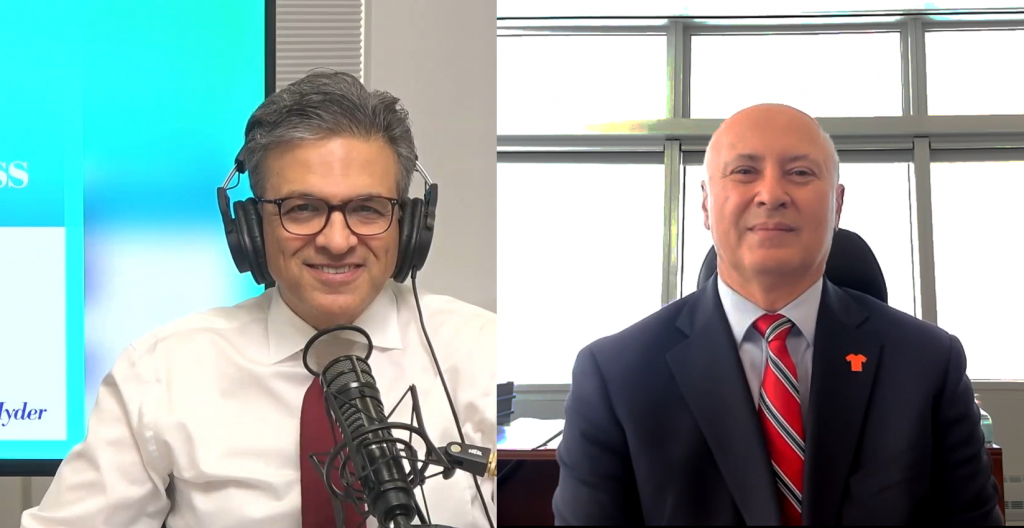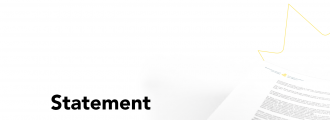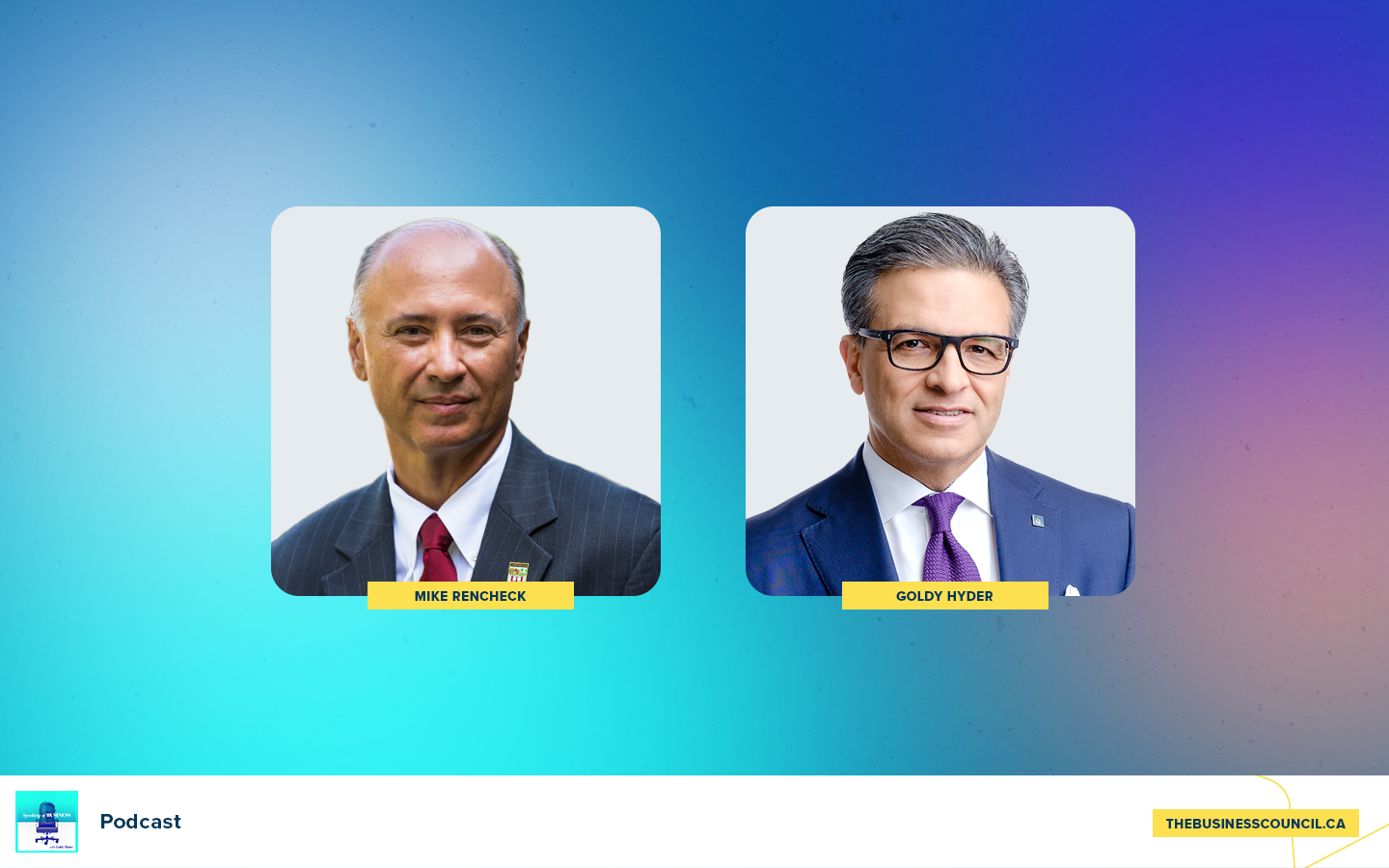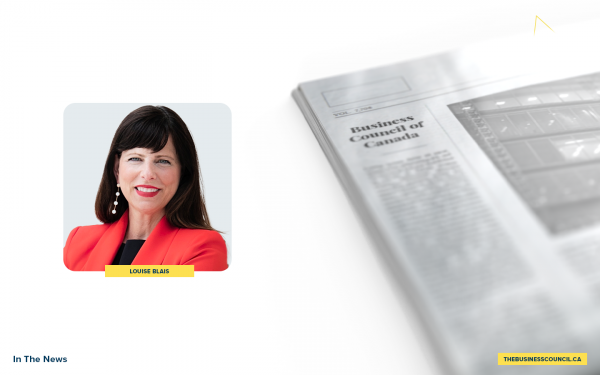Leading the way in nuclear energy: Mike Rencheck, Bruce Power
It was a summer job that sparked Mike Rencheck’s lifelong career in the energy industry. He started out as an intern at the Beaver Valley Power Station in Pennsylvania in the 1980’s, and never looked back. “It really opened my eyes to what was possible in nuclear energy,” he says.
Skip ahead a few decades and Rencheck is now the President and CEO of Bruce Power. The nuclear plant on the shores of Lake Huron produces 30 per cent of Ontario’s electricity – that’s half of all the province’s nuclear power.
Rencheck recognizes the important role nuclear will play as Canada transitions to lower emissions energy sources. “We really need to progress forward if we’re going to have a clean energy transition and have abundant energy that’s reliable, clean, and affordable,” he tells Goldy Hyder on the Speaking of Business podcast. It’s why Bruce Power is looking at adding more production capacity at its site – an additional 4,800 megawatts of electricity (Bruce Power currently produces 6,550 megawatts).

And Bruce Power doesn’t stop there. The company is, in Rencheck’s words, a “superpower” in the production of medical isotopes. The life-saving products are used to sterilize medical equipment worldwide and to treat some forms of cancer.
In a wide-ranging conversation, Mike Rencheck and Goldy Hyder also discuss Indigenous reconciliation, the value of asking questions, and how to unleash Canada’s “get ‘er done” mentality.
“We have great people in Canada. We have great people here at Bruce Power. And when we choose to work together, we simply get things done.”
Listen to the entire conversation with Goldy Hyder on the Speaking of Business podcast.
Subscribe
You can find Speaking of Business wherever you get your podcasts.
Latest Podcasts
Transcript
Mike Rencheck:
We have great people in Canada. We have great people here at Bruce Power. And when we choose to work together, we simply get things done.
Goldy Hyder:
Welcome to Speaking of Business, conversations with Canadian innovators, entrepreneurs and business leaders.
I’m Goldy Hyder, President and CEO of the Business Council of Canada. What was your most memorable summer job? What did you learn from it? For me, it was a job I landed in 1985 with Agriculture Canada in Calgary. I learned a lot about how government works and it inspired me to be engaged in public service. For Mike Rencheck, his summer job sparked a lifelong career in the energy industry. In 1982, he was a summer intern at the Beaver Valley Power Station in Pennsylvania. Skip ahead a few decades and Mike is now the President and CEO of Bruce Power. The nuclear plant on the shores of Lake Huron produces a whopping 30% of Ontario’s electricity. For context, that’s half of all of Ontario’s nuclear power. How has the industry evolved since Mike started out in the 1980s and what role will nuclear play in Canada’s future energy mix? I’m just thrilled that Mike is here to talk through it all with us. Welcome to the podcast, Mike.
Mike Rencheck:
Thanks, Goldy. It’s great to be here today.
Goldy Hyder:
Well, let’s start back in 1982. I mentioned the summer intern at Beaver Valley Power Station. What do you remember about that time and how is it that that led to this?
Mike Rencheck:
Oh, that’s four decades ago. Can you even remember back to 1982?
Goldy Hyder:
I forgot what I had for lunch, if that helps.
Mike Rencheck:
Oh, geez. Yeah, no, it was a summer job and at that time the steel mills in Western Pennsylvania were all closing. So finding a place to work and finding a good summer job brought me to Beaver Valley Power Station, Duquesne Light Company, and it was a great summer job. At the time we were building Beaver Valley Unit 2 and Unit 1 was just in operation. It was an exciting time to be in the industry.
Goldy Hyder:
Did you think that this would lead to where you got to at that point in time?
Mike Rencheck:
At that point in time, I was still in college really wondering what those next steps might look like as you graduate. But the turn of events that happened in Pittsburgh at that time was really ominous. The entire steel industry shut down between 1982 and 1983, and as a result of that, I found my family really unemployed and at that time my dad was able to retire, but he had asked me to come home because he wasn’t quite old enough to receive a pension from the U.S. Social Security system. So I ended up coming back home and then rejoining Beaver Valley at that time to help support the family. But it was one of those things, as a young engineer at that time, computers were just getting started. So the allure of going out and doing things digital was there, but I knew I had to come home and that really launched my career. As I really joined the workforce from that summer job, it really opened my eyes up to what was possible in nuclear energy.
Goldy Hyder:
Mike, I can’t help but notice you’re not wearing a Bruce Power lapel pin, but you have a very prominent orange shirt pin that you’re wearing. Tell me about that.
Mike Rencheck:
I wear an orange shirt every day since we found out about the residential schools. It’s a commitment that we’ve had here locally that the next 50 years don’t have to be like the last 50 years. And as we look forward, it’s very symbolic of nuclear energy as well and energy as a whole. These next 50 years, we can make a difference. We can change through a clean energy transition. They don’t have to look like the last 50 years. So I find a lot of symbolism in that and looking forward, we want to make the world better, we want to do better things here at Bruce Power, and I think it’s very fitting for what we’re working on and working to accomplish.
Goldy Hyder:
Yeah, that’s terrific. Great leadership, Mike. One of the things of course that when I talk to C-suites across the country that’s the big issue, and there’s so many it seems like, but talent continues to be high on the list of things that the C-suite continues to focus in on, and we just mentioned Indigenous, youngest population in the country, 50% below the age of 25. How are you doing in terms of recruiting from there? But more broadly, how are you managing talent?
Mike Rencheck:
For us, we have a purpose. We’re making a difference and we communicate that message. In other words, we’re providing clean energy to Ontario. We also provide medical isotopes that save lives every day. I think it’s that purpose of protecting the environment, building strong communities, securing the future is really an attraction for us, Goldy. Over the last few years, we’ve had about a thousand open positions. We’ve had upwards of 30,000 applications for those positions. Think about that, 30,000. What we look at is we want people to be here that have a positive attitude, are capable of learning, action oriented, bias for action, working to get things done in a safe and orderly manner, and it’s inclusive. We recruit from all over Canada and really throughout the world, especially for some specialties. So you’ll see a very diverse workforce here at Bruce Power, and we’re recognized for this over and over again. We win a lot of best places for young people to work, best diversity workforce, best place to work awards. We care about our people and we care about that recruiting process.
Goldy Hyder:
The industry itself, let’s be candid, had gone through a pretty dark period for a period of time here where it was frowned upon to some extent. People weren’t looking to nuclear to be a part of the solution, to be a part of the mix. But it sure seems to be making a comeback and a really strong comeback. Our own prime minister has acknowledged that while he is an environmentalist, he was opposed to nuclear. He certainly now feels it needs to be a part of the mix to get to net zero. How are you feeling about the industry itself right now?
Mike Rencheck:
Finally folks are realizing that if we’re going to have a clean energy future, nuclear has to be part of that equation. When you look around the world right now, the move towards intermittent resources really has caused a lot of grid integration issues with reliability resiliency. But that combination of intermittent resources with a clean energy base load like nuclear hydro, you see that, stabilize out, really provide that sense of energy security for citizens. So I think as we look forward, countries and regional locations will use the resources that they have available, and I think you’ll see nuclear being more and more part of that mix just from an energy security perspective.
Goldy Hyder:
Certainly here in Ontario where you and I both are, 30% of Ontario’s electricity that I mentioned. Just how big is this operation and where is it going? And that number may be even growing.
Mike Rencheck:
Yeah, it is. It is. So here in Ontario, 60% of the electricity is provided by nuclear, about 25% by hydro, and then we have about 8% wind and solar backed up by natural gas and then some biomass. So the grid here in Ontario is very clean. It’s about 94% carbon free. So we are a model for the world in terms of how to decarbonize the electric sector. In fact, you can plug in anywhere on Ontario’s grid and you’re getting effectively CO2-free energy.
Deep decarbonization, as an example, is believed to be below 50 grams equivalent of CO2 per kilowatt hour. Here in Ontario, we’re about 35 grams total. And as a whole, Canada has a very clean electric sector already. So we’re well ahead of the curve. And then here at Bruce Power, we’re running Canada’s largest private sector infrastructure program in renewing six of our reactors. As we’re doing that, we’re also going through a power upgrade process. So when we started, we were about 6,300 megawatts. Today we’re 6,550 megawatts, and by the time we’re finished in 2030, we’ll be over 7,000 megawatts as a site. So effectively we’re adding another reactor to the site as we’re going through our life extension.
Goldy Hyder:
I know you mentioned expansion, you’re looking at expansion and continuing to try and bring about that clean energy. What are some of the considerations that are going into that? Because certainly, you read the news, it’s hard to build things in this country, or how are you overcoming some of those challenges?
Mike Rencheck:
Yeah, that’s a really good question. Here in Tiverton, Ontario, it’s eight reactors. Nuclear has been part of the community here since 1968 when the original Douglas Point reactor was built. So as a site and as a community or a province, we’re very used to nuclear energy being available here and supplying our grid. As part of that as we look towards the energy transition, we know here in Ontario as a result of our IESO study, we’ll be needing another 88,000 megawatts by 2050 to fully decarbonize the grid and other industries in the province. That paves the way for new nuclear. Part of that study, the IESO’s predicting we’ll need about 18,000 megawatts of additional capacity, and this summer the province of Ontario has asked Bruce Power to consider looking at adding an additional 4,800 megawatts of electricity here at the site.
So what’s in the way of that? Well, we have to go through an impact assessment process at the federal level and different permitting. I would argue if there’s ever a better place to build a nuclear plant, it’s at this site. It’s likely one of the most studied pieces of properties in Canada, and we’ve been doing nuclear here since 1968, so it’s not something new. So we’re working with the Impact Assessment organization and a Canadian Nuclear Safety Commission to look at how we might have a tailored process that would take credit for all those studies and all those reviews that have been done over the decades and most recently completed in 2022 to help streamline a process for permitting and really start to demonstrate Canada’s leadership in nuclear worldwide.
So as we are building here at the site or looking to build here at the site, our partners in Ontario, Ontario Power Generation, they’re building a small modular reactor down at the Darlington site, and also as part of the announcements this summer, they’ve expanded from one small modular reactor to four. So I think collectively we have a good step up on the world to be able to process this and we really need to be begin to move the ball forward.
Goldy Hyder:
Well, a number of things you’ve said there I want to pick up on. So let’s start first with sort of the best practices, if you will, the comparisons. You obviously would be aware of how other countries are doing with nuclear, how long it takes to get their facilities up and running. How are we doing in Canada in terms of the permitting piece? Are we competitive or we got work to do?
Mike Rencheck:
We have some work to do. As I look at the new process, the original view, it would take seven years to permit our site here at Bruce Power to be able to put a reactor on it. But working with the Impact Assessment organization and the CNSC, we’re thinking we can get that down to about two, two and a half years, and we’re working our way through that now with both of the agencies, and there’s great cooperation here and great leadership in the Impact Assessment and CNSC to cause that to happen. But as you know, until we get pen to paper and really start to document and set those principles in motion, things can run awry. So great work. We got a lot of work to do in that space and we’re looking forward to getting through that in a timely and effective manner.
Goldy Hyder:
And ultimately it trickles down, right? Not only does it help the consumer, reliable clean energy, it helps the environment at the same time in terms of trickling up. You would think there’s a win-win here for everybody.
Mike Rencheck:
Oh, it’s a win-win-win. Creates great jobs, a great economy. Protects the environment and builds communities.
Goldy Hyder:
Terrific.
Mike Rencheck:
When you look at what we’re doing just with our life extension program as an economic development platform, we’re effectively influencing three counties and seeing a rebirth in rural Ontario of an area that really faced a major decline as a result of the industrial recession in the late 2000s there, 2009 timeframe, 2008 timeframe.
Goldy Hyder:
Now, as you know, Canadian industry is really leading the world on the green transition. We know that it’s going to take a lot of innovation. Members are working on things like carbon capture, on hydrogen, and I must say I am a salesman for SMRs around the world, you’ll be happy to know. It sure seems like a sure thing that this is going to work, the capacity of these SMRs to really help those cities in China and India and other parts of the world that are running coal plants to use modular reactors. What is the promise of these? How do you feel things will happen and how quickly will they happen in terms of how SMRs can be utilized around the world?
Mike Rencheck:
So think back in time. When was the very first small modular reactor? Well, it started in the US Navy and there are hundreds of them that have been in service in submarines and aircraft carriers for years. So the technology that is used there is known and proven. Also throughout the 1960s and 1970s, there were a lot of demonstration sites around the U.S. and around the world on different technologies as they finally settled on the CANDU here in Canada and light-water reactors in other places.
And the symbolic thing for me is when I started at Beaver Valley’s Power Stations, it’s actually in Shippingport, Pennsylvania, and the very first commercial reactor started up in 1959 on that site right next door, and it was taken out of service at the end of 1992, which was my first year there. So I think these technologies are going to unfold. It’s going to take some patience. We’re going to have to continue on with the demonstration projects that are being built throughout the world, and you’re seeing that happen globally. And then here in Canada, OPG is building a small modular reactor, the GE-BWRX-300. It’ll pave the way for use here in Canada, but in partnership with other countries around the world really open the doors to widespread adoption.
Goldy Hyder:
Now, what I know about SMRs, I know from you, my friend, because I remember you telling me the difference between the current size ones, which are like 1600 or something like that. These modular ones are more in the 500 range, and then there’s these personal nuclear reactors as well. And when you think about nuclear, the issues of safety, use of water and management of waste come up. How can SMRs be a game changer with those issues?
Mike Rencheck:
Yeah, first of all, I think the existing reactor fleet fits all of those conditions today. I think with the small modular reactor, what it changes for us is the ability to place those reactors in different locations, and for countries who don’t have large grids, to be able to enter the nuclear technology space and have a reliable source and a dependable source of energy there to supplement other sources that they have. I think that scalability now in nuclear, seeing going from very small, maybe the size of small batteries to small modular reactors, a few hundred megawatts, to the large reactors really create that portfolio of generation sources that can be placed now around the world depending on the needs.
For example, you’ll see France continue to use large reactors because of the population density in those areas. U.K. is building Hinkley Point and considering other locations and the French have announced further additions. You’ve just seen Finland put online a reactor and the United Arab Emirates put on four large reactors. You’ve also seen the advent of small modular reactors begin here in Ontario. You have the Tennessee Valley Authority in the U.S. pursuing that as well. And then a number of demonstration projects underway. And it seems like every day you pick up the paper, there’s a new MOU signed and another announcement for different countries considering to move forward with small modular reactors and large reactors.
Goldy Hyder:
Now, despite this push here and their acknowledgement really by even the environmentalists that the energy mix is going to require nuclear to truly decarbonize, there are still those who are unconvinced and part of their argument is their concerns about nuclear waste and their concerns about nuclear accidents. What happens to the waste? What response do you have to these critics?
Mike Rencheck:
I’ve heard that for about 40 years, as long as I’ve been in the industry. I would look at it this way. It’s the only industry that captures its waste and contains it. I can’t think of another industry that is responsible for the waste that it produces in that manner. And as an example, our Bruce Power units were brought online in the 1970s and 1980s and 1990s. That amount of electricity for Ontario that has been there all those years, the amount of waste produced fits in an area less than a size of a football field and is contained in canisters and pristinely clean buildings. It hasn’t gone anywhere. It isn’t going anywhere. So it’s completely contained. You look at other industries in this aspect, they get a free pass on this. They just simply get to put their waste out into the environment.
So the Bruce A units were historically closed in the late nineties. When the Bruce A units were restored here in Ontario, we were able to phase out coal. What that means for Ontario is that we had a peak of about 53 smog days in, say, 2005, 2006 timeframe. And when the Bruce A units were restarted, we have zero smog days today. There may be a few hours of inversion, but that’s primarily due to the transportation sector and industrial processes. So I would argue that environmental benefit has prevented respiratory disease, cardiovascular disease, and saved thousands of lives. We have a way of maintaining and storing the waste. In France, they actually recycle and reuse it.
So it’s more of a political will, and I would say there’s a lot of misinformation outstanding around nuclear waste. It’s simply years ago, the industry just didn’t do a good job talking about it. But today you see younger people now taking this mantle forward explaining these myths and misinformation. And in fact, recently there was an environmental activist calling out Greenpeace saying this anti-nuclear is old-fashioned and out of date. We really need to progress forward if we’re going to have a clean energy transition and have abundant energy that’s reliable, clean, and affordable.
Goldy Hyder:
That’s great to hear. I mean, you’ve had a chance to, with your explanation here, sort of clean up those misperceptions, if you will. One of the other things about nuclear that again got some attention some time ago up in AECL and others was around medical isotopes. You’re also involved with medical isotopes. You’re not just producing energy. Tell me a little bit about that. What do you do?
Mike Rencheck:
We’re more than involved. We’re a superpower in the production of medical isotopes here in Canada, and Bruce Power is one of the largest producers in the world. We make, as an example, Cobalt-60, which is used for sterilization. The amount of Cobalt-60 we make, we send to Nordion. We sterilize about 40% of all the once used medical devices worldwide. So during the pandemic, when you think about all the medical equipment that was being used, there’s a 40% chance that was sterilized by a Cobalt isotope that we make here in Tiverton, Ontario and it’s processed by Nordion and provided by Canada. So Canada has been a major player for a long time and continues to be a major player in medical isotopes for sterilization. But we also make medical isotopes that help save lives through cancer treatments. We make Cobalt-60 in another form that’s used to power the Gamma Knife for brain tumor treatments.
Sometimes these things hit personally home. I’m sure many of us know someone who has had cancer before. And here in my family, we have a relative that has a brain tumor and just found out that she’ll be using the Gamma Knife for follow-up treatments. So knowing that we’re providing the isotopes that will help cure her is personal. We’ve also put a new production system in place now that enables us to make medical isotopes while we’re in operation all the time. It’s a first commercial system like that. And the first isotope we’ll make is Lutetium-177, which is a prostate cancer treatment. That element is being put in cancer treatments now and being broadly used around the world, and it’s in a new area called theranostics that’s being developed.
Dr. Rebecca Wong in the Princess Margaret Hospital here in Toronto is doing a lot of research on using Lutetium as a full body cancer treatment. In other words, she’s using it at a process called theranostics where she is doing diagnosis and treatment at the same time. And she started small. Now she has a whole department on this. And she’ll show radiographs of a torso full of cancer. And then after treatments with Lutetium, it’s effectively gone. And it’s like every time I see that, it sends chills up my spine. But the important part for Bruce Power is with our very first production run of this system, we were able to make more Lutetium-177 than was made everywhere else in that world to that point in time for the year. Now we can do that every week and a half. So the scale of that means that this drug can become widely available for widespread use, and we see the pharmaceutical companies now gearing up to be able to provide that.
Goldy Hyder:
That’s terrific. What a great story for Canada and for people who suffer from cancer and need the treatments. We talked a little bit earlier about the importance of Indigenous reconciliation. You have a partner in the medical isotopes business. Tell us who that is and why they’re there.
Mike Rencheck:
Yeah, it’s exciting. We call our joint venture Gamzook’aamin Aakoziwin, and our partner is Saugeen Ojibway Nation. And what it means is we fight the disease together. So it’s been a way for us to be able to create both alignment with the Indigenous communities, but at the same time a business venture that provides an income stream back to the community. So it’s a great partnership and it’s also a great partnership with the government in that the Saugeen Ojibway Nation received a grant from the federal government for their portion of the investment. So it really is a win-win-win. And we’re looking at expanding that partnership. Actually in the process now of expanding these production systems, both for Cobalt and for Lutetium-177 and our partnership with the Saugeen Ojibway Nation in the production of Lutetium.
Goldy Hyder:
I want to talk a little bit about your own journey. You mentioned you started off in the U.S., you’ve worked there, you worked in France, and you were in Paris right up until 2016, and then you moved to Bruce County on the shores of Lake Huron, which for those who’ve seen it is a very, very pristine, beautiful part of our country and of our province. How was it though from moving from Pennsylvania to Paris to Bruce County?
Mike Rencheck:
Well, we grew up in a small town, my wife and I, so moving to Bruce County, it’s kind of like coming home, really. And in fact, so much so that we became Canadian citizens in 2021. But it was a great career that led me really through many states throughout the U.S. and then to Paris. Quite the experience working in a big city like Paris, just a beautiful city. So you see one side of that, and then when you come to Bruce County, it’s just pristine here, and there’s no better place in the world to be than in the summertime. It’s one of the best kept secrets, I think, in Ontario, if not Canada, and to be here in the summertime months and along the waters of Lake Huron, the crystal clear waters of Lake Huron, it’s just an amazing place to be.
Goldy Hyder:
Your journey, I’m sure, wasn’t a straight line. And this is one of the things we like to talk about in the podcast is I have an opportunity, very privileged one, to interact with CEOs of different companies across this country with different experiences. And I’m just wondering, when you look back at your experience and what you’ve had to go through, what lessons did you learn from that?
Mike Rencheck:
I’ve learned a few lessons over the years from those jobs, Goldy. And some of them I think are just common sense things as well. Never be afraid to ask. The worst you’re going to ever get told is no, and you never know when you’re going to get told yes. And that creates opportunities, whether you’re told no or yes. So that’s one of the lessons learned. But I also always took the jobs on that were hard, that no one else wanted, because they were difficult, they were complex, they required scale. And I think I learned so much from those things at a young age in terms of just management techniques, how to involve people. It was really beneficial. You learn so much from doing things that are difficult, and sometimes when they’re hard and they’re worth doing, they’re so rewarding you want to keep doing them. And I found my career over and over again just getting great enjoyment out of that.
Goldy Hyder:
What role would you say failure has played in your leadership journey?
Mike Rencheck:
There’s no better teacher. If you have not failed, then you’re not really doing much. And if you’ve tried some things and they haven’t worked, you got to learn from those. I used to have on my desk and I have it on my desk at home now, is the motto THINK. And it came from the original founder of IBM, Tom Watson. And one of the parables that struck me early in my college years was it was a statement that he made along the line of you can try something and fail. Why would I fire you? That’s the best education one can get. I couldn’t pay for you to have that kind of education. And I’ve carried that with me throughout my career, not being afraid to try things. And you learn so much along the way. The setbacks teach you resiliency. And then the creativity and the innovation to overcome that and still have a successful result.
Goldy Hyder:
Can I ask what advice you give your kids about these kinds of things?
Mike Rencheck:
Don’t be afraid to ask. Don’t be afraid to try new things.
Goldy Hyder:
So you’re sticking to what got you here?
Mike Rencheck:
Well, I stick with that, and they’re doing quite well. They’re much smarter than I am. I think this whole younger generation, when you look at some of the younger students now that are graduating, what they’re equipped to accomplish and do, it’s amazing what they’re learning now at the educational levels coming forward.
Goldy Hyder:
Well, thank God they are smarter than us because unfortunately, we’re not leaving them a very good hand in many ways, and you and I have talked about this as well, our love for our country, our love for the region in which we live, and the world in which we’re operating, but it’s a bit of a mess, right? I mean, we’ve got the climate situation, we’ve got the fiscal situation, eroding infrastructure, polarization, affordability issues. You talk to your kids as I do mine, they’re very stressed about their futures. What can we do? What do we need to do to turn this around, to give them hope and to give them the opportunity that this can be fixed, that a course correction can happen? What’s missing? What’s keeping us from doing that?
Mike Rencheck:
Yeah, we need to get on our way and start getting things done, and that’s what we focus on here at Bruce Power. We have within our capability to do things, like renewing our reactors, like expanding their output, like improving their availability and reliability. We can do these things like making medical isotopes. It takes that creativity, that innovation, and that will to get things done and to help remove roadblocks along the way. We all have to participate in that. That means collaboration. That means collaboration between federal government, provincial government, and the business community. When we work together to achieve an outcome, we can do these things.
We have great people in Canada. We have great people here at Bruce Power. And when we choose to work together, whether it’s our suppliers, the trades, the people here, we simply get things done. Goldy, I’ve been told my entire time that big nuclear can’t get done on time and on budget. Well, we just put our Unit 6, we just refurbished the reactor basically replacing pretty much everything. And we did that through a pandemic and we finished it with one of the best safety records for large projects, high quality, all tests pass first time ahead of schedule and on budget.
Goldy Hyder:
Congratulations.
Mike Rencheck:
Thank you. And that’s congratulations to the people that work here at Bruce Power, to all of our suppliers, and to the building trades. We wouldn’t have been able to do that working through the pandemic if we weren’t working as a team. There were points during the pandemic, Goldy, we had 10 to 12,000 unique people coming to work at site each week during the peak of the pandemic. We ran 150,000 COVID tests here. And not only did we look after-
Goldy Hyder:
I remember you telling me you had housing for them and everything set up.
Mike Rencheck:
Yeah, for sure. And they looked after each other here, but they also went out into the communities. We were working at food banks, we were working, sending PPE to hospitals. We set up hockey hub vaccination centers. So it wasn’t just here. We were helping the communities that surround us, and we were also helping the province through this process. So like many companies stepped up, we’ve shown through this when we work together, we can get things done.
Goldy Hyder:
You have a lot of humility, and you didn’t mention this, but I want to say it, but I also know that those teams work because there’s a leader and leadership matters, and I want to talk about Canada, if I can. My purpose, and I’m going to end with this because you mentioned you’ve gained your Canadian citizenship, you and your wife, so welcome to Canada. Welcome to being Canadian. And part of what we like to do is naval gaze and trying to think about where are we in this big scheme of things? How are we doing? How do we stack up? What do you see here? You came from a country, from the United States, the kind of get ‘er done attitude country. What do you think we need to be doing in Canada in terms of setting this growth prospects for this country, the trajectory of this country to really lead in the world?
Mike Rencheck:
Well, Canada has a get ‘er done type attitude too. We just need to unleash that. We need to let people get about doing what they’re good at, making it easy. For example, easy to get a permit here, to build new nuclear, easy to be able to create business and let our people do the things that they’re good at doing. And when we do that, we’ll get great results. And I think that’s the role of government. We have to help businesses, we have to help people, and we’ve got to make it easier to get some of the things done that we need to do.
Goldy Hyder:
That’s sage advice, my friend. Thank you for doing this. I really appreciate it. It’s great to see you and great to hear your wisdom being shared with our listeners.
Mike Rencheck:
Thanks, Goldy. It’s been a pleasure to be here. I’m just so bullish on what we can accomplish. Like I said, we’ve got great people here at Bruce Power. We’ve got great people in Canada. Our industry is looking to lead the way in a clean energy transition. Our partners at OPG are putting their refurbishments in on time and on budget. We’re doing that. Let’s get on with the next steps and really make a difference in the world.
Goldy Hyder:
Get it done, as we said. Get it done. Excellent. Thanks, Mike. Appreciate it.
Mike Rencheck:
Okay, Goldy. Take care.
Goldy Hyder:
Mike Rencheck is the President and CEO of Bruce Power. If you’ve been enjoying our Speaking of Business conversations with innovators, leaders, and entrepreneurs, why not subscribe to our podcast? Search for Speaking of Business wherever you get your podcasts, or simply go to our website at thebusinesscouncil.ca. Yes, that’s thebusinesscouncil.ca. Until next time, I’m Goldy Hyder. Thanks for joining us.












